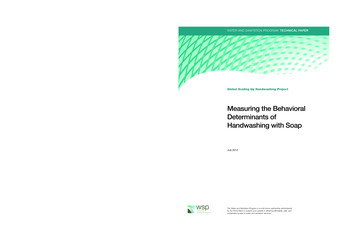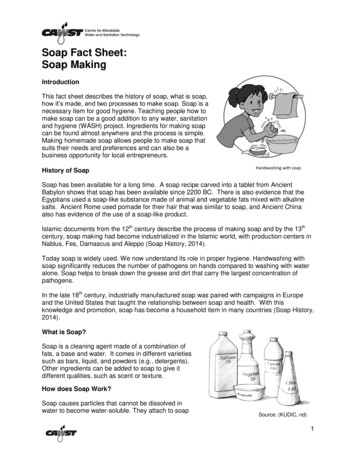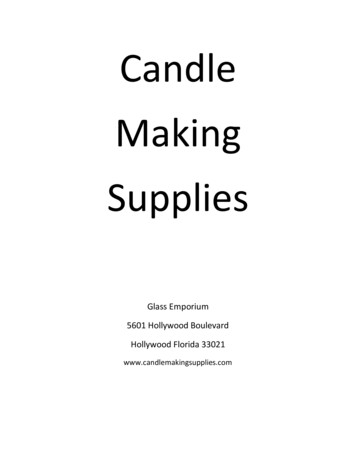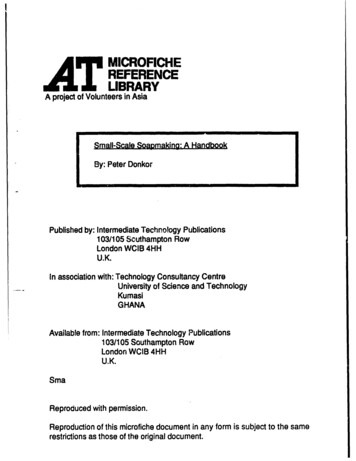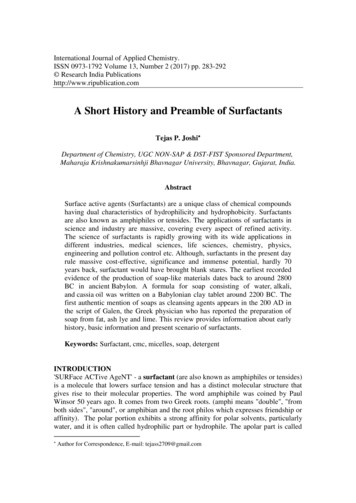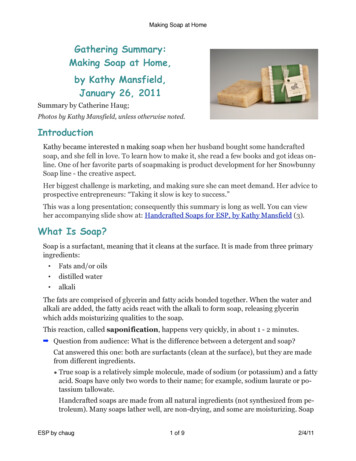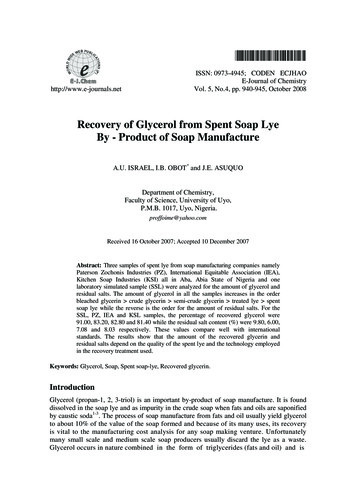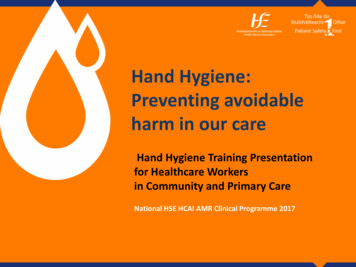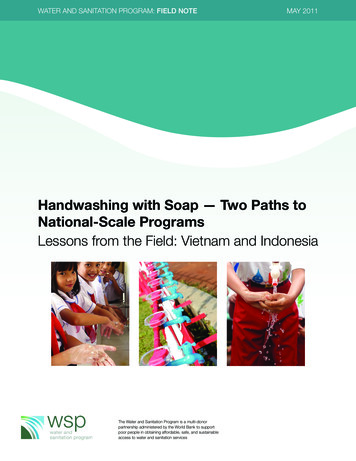
Transcription
WATER AND SANITATION PROGRAM: FIELD NOTEMAY 2011Handwashing with Soap — Two Paths toNational-Scale ProgramsLessons from the Field: Vietnam and IndonesiaThe Water and Sanitation Program is a multi-donorpartnership administered by the World Bank to supportpoor people in obtaining affordable, safe, and sustainableaccess to water and sanitation services
Acknowledgments:This document was written by Penelope Dutton with contributions fromIsabel Blackett, Nga Kim Nguyen, Ida Rafiqah, Wendy Sarasdyani,Minh Hien Nguyen, Amy Lynn Grossman and Almud Weitz. It was peerreviewed by Nathaniel Paynter and Jacqueline Devine.Contact Us:For more information please visit www.wsp.org or emailwspeap@worldbank.org.The Water and Sanitation Program (WSP) is a multi-donor partnershipcreated in 1978 and administered by the World Bank to support poorpeople in obtaining affordable, safe, and sustainable access to waterand sanitation services. WSP provides technical assistance, facilitatesknowledge exchange, and promotes evidence-based advancementsin sector dialogue. WSP has offices in 25 countries across Africa, EastAsia and the Pacific, Latin America and the Caribbean, South Asia, andin Washington, DC. WSP’s donors include Australia, Austria, Canada,Denmark, Finland, France, the Bill and Melinda Gates Foundation,Ireland, Luxembourg, Netherlands, Norway, Sweden, Switzerland, UnitedKingdom, United States, and the World Bank. For more information,please visit www.wsp.org.WSP reports are published to communicate the results of WSP’s workto the development community. The findings, interpretations, andconclusions expressed herein are entirely those of the author and shouldnot be attributed to the World Bank or its affiliated organizations, orto members of the Board of Executive Directors of the World Bank orthe governments they represent. The World Bank does not guaranteethe accuracy of the data included in this work. The boundaries, colors,denominations, and other information shown on any map in this work donot imply any judgment on the part of the World Bank Group concerningthe legal status of any territory or the endorsement or acceptance ofsuch boundaries. 2011 Water and Sanitation Program
Handwashing with Soap—Two Paths toNational Scale ProgramsLessons from the Field: Vietnam and IndonesiaEXECUTIVE SUMMARYThis Field Note describes two Southeast Asian programsthat are making handwashing a feature of everyday liveson a national scale: the Handwashing Initiative (HWI) inVietnam, which has reached nearly two million caretakers ofyoung children and 80,000 students; and the Public-PrivatePartnership for Handwashing with Soap (PPP-HWWS) inIndonesia, which has contributed to reaching millions ofstudents, mothers, workers, and travelers. The program inVietnam has concentrated on first gaining an understandingon how people actually behave and then determining howto change that behavior, while the program in Indonesialeverages the reach of the private sector and other partnersto scale up handwashing initiatives that were previouslyresearched and already underway. They both demonstrateideas that can be applied in other countries.For countries about to embark on designing either a standalone handwashing program or a handwashing componentwithin a larger water and sanitation program, the process ofdeveloping evidenced based materials in Vietnam could beapplied in the development of materials. The Indonesia casestudy provides insights on how to leverage partnerships toincrease reach in countries where handwashing with soapprograms already exist.This document is most useful for: Practitioners who see the need or potential for a nationalscale handwashing with soap promotion program, Governments, and practitioners such as NGOs, whowant to add a hygiene component to a new or existingwater and sanitation program, and Organizations who are interested in examining public-www.wsp.orgprivate partnerships outside of traditional hardwareprograms.These two examples show that there is no single approachfor national handwashing programs. Individual countrycontexts — population size, government leadership,budget, prior hygiene programs, and willing partners —determine the path of national programs. In Indonesia, thePPP-HWWS has reached a much wider target audiencethan the government or development organizations,working independently from one another, could havereached. Experience in Vietnam has shown that a publicprivate partnership model is not essential for a large-scalehandwashing program. The national government wasinvolved in the development of evidence-based materialswhich were then acceptable to other partners for scaling up,including through provincial government partnerships.Common lessons learned are that: Behavior change messages must be based on researchand developed by professionals Consistent messages and information about the criticaltimes for washing hands will improve implementationefficiency Implementers need to be trained in behavior changepromotion techniques Build on earlier handwashing work to jumpstartpartnerships A national logo is valuable to unite all stakeholdersaround the common message and campaignBoth Indonesia and Vietnam demonstrate that if nationalprograms welcome new and different partners or promotion3
FIELD NOTE: Handwashing with Soap — Two Paths to Starting Up National-Scale Programsopportunities, then the reach of handwashing promotioncan be enormous.Challenges remain for the handwashing with soap programsin Indonesia and Vietnam and include: Ensuring handwashing promotional materialsare inclusive of all people in these ethnically andgeographically diverse countries, Obtaining more physical investment in water supplyand handwashing stations in schools to enablehandwashing with soap, and Setting up monitoring and evaluation processes togive feedback and guide the future direction of theprograms.INTRODUCTIONAlthough mortality rates for children under five aredeclining in both Vietnam and Indonesia, in 2007 diarrheaclaimed the lives of more than 27,000 children under fiveyears of age in these countries. In Indonesia in particular,diarrhea causes 18 percent of all deaths of children underthe age of five, compared to 10 percent in Vietnam.1Many thousands more children every year are unwell andmalnourished because of diarrhea and other illnesses thatare transmitted through poor hygiene. In some areas ofVietnam, 92 percent of school children have intestinalworm infections, while three-quarters of women nationally,including pregnant women, are infected with one or moretype of worm.2 The simple action of washing hands withsoap has been demonstrated to reduce the incidence ofdiarrhea by up to 47 percent and acute respiratory infectionsby up to 34 percent.3,4 Washing hands with soap can alsoreduce the spread of SARS, cholera, Avian Flu, and H1N1along with other emerging infectious diseases that occur inSoutheast Asia.Vietnam and Indonesia are two of 15 developing countriesaround the world that are part of the global Public-PrivatePartnership for Handwashing with Soap. The PPPHWwas established in 2001 through the Global HandwashingInitiative5 to promote handwashing with soap at a nationalscale, using partnerships between the private and publicsectors. PPPHW programs target children, mothers,teachers, and caregivers. Indonesia has gone on to furtherdevelop these partnerships, while Vietnam’s approachinitially built on the PPPHW but now has more bilateralarrangements through its Handwashing Initiative.6This Field Note describes the success of two differentapproaches in meeting the huge challenge of scalingBOX 1. GUIDING PRINCIPLES OF PUBLIC PRIVATEPARTNERSHIP FOR andwashing (PPPHW) works to save children’s livesby promoting the awareness of this simple practice. Thepartnership is guided by the following principles: These deaths are preventableResearch shows that, if widely practiced, handwashing with soap could reduce diarrhea by almost 50percent and respiratory infections by nearly 25 percent. Handwashing with soap is a rightEvery child has a right to vaccination and should alsohave the right to protection from hand-transmitteddiseases. Large-scale changes in handwashing practicescan be achievedA large-scale increase in the practice of handwashing with soap would make a significant contribution tomeeting the Millennium Development Goal of reducing deaths among children under five by two-thirds by2015.UNICEF. 2008. Indonesia Country Profile, Maternal, Newborn & Child Survival; and Vietnam Country Profile, Maternal, Newborn & Child SurvivalLe, H.T., et al. 2007. “Anemia and intestinal parasite infection in school children in rural Vietnam.” Asia Pacific Journal of Clinical Nutrition. 2007;16(4):716-23. and Nguyen, P. H., et al.2006. “Intestinal Helminth Infections Among Reproductive Age Women in Vietnam: Prevalence, Co-Infection and Risk Factors.” Southeast Asian Journal of Tropical Medicine and Public Health,2006:37(5).3. Curtis,V; S. Cairncross. 2003. “Effect of washing hands with soap on diarrhea risk in the community, a systematic review.” Lancet Infectious Diseases 3:275-281.4. Luby, Steve, et.al. 2005. “Effect of handwashing on child health; a randomized control trial.” Lancet Infectious Diseases 366:225-33.5. The Global Handwashing Initiative was developed by an alliance of the World Bank, the Water and Sanitation Program, the London School of Hygiene and Tropical Medicine, the Academyfor Educational Development, and the private sector, in collaboration with USAID, UNICEF, and the Bank-Netherlands Water Partnership6. The Government of Vietnam was not ready for a multilateral partnership for handwashing, and already had programs in place with UNICEF and Unilever that were consolidated under theHWI.7. http://www.globalhandwashing.org/1.2.4www.wsp.org
FIELD NOTE: Handwashing with Soap — Two Paths to Starting Up National-Scale Programsup handwashing to a national level. In Vietnam, thefocus is on well-researched and targeted communicationprograms delivered through a mass organization andschools. In Indonesia, efforts concentrate on national levelcoordination and leveraging private sector participation toencourage handwashing. In both countries, handwashinginitiatives have been adapted to local circumstances withsome interesting and unexpected results.FIGURE 1: VIETNAM COUNTRY DATAThis document details ideas and approaches for designingand implementing behavior change programs, and fosteringprivate sector participation. It describes lessons learned inrelation to implementing national handwashing with soapprograms. The approaches and lessons learned will have mostuse for those countries wanting to scale up handwashing toreduce diarrheal and other infectious diseases.Primary school enrollment:Area:331,210 km2Population: (2009)85.8 millionNumber of provinces:64Children under 5:8.4%Life expectancy:Males 70Females 76Under 5 mortality:15 per 100096%Source: CIA World Factbook, 2009 National Census, UNICEF 2008104 MengziMeCHINA108 WenshannkogNanningLai ChauedTuyenQuangYen BaickXam NuaVIETNAM HANDWASHING INITIATIVEHaDongHaiphongXuwenThai BinhKy SonGulfofTo n k i nXiangkhoangDien ChauNanHaikouDao BachLong ViThanhHoaBanBanLouangphrabangZhanjiangDao Cai BauHong GaiHaiDuongNam DinhNinh BinhLAOS20 BeihaiBac GiangHanoiHoaBinhLouangNamthaQinzhouPingxiangLang SonThaiNguyenVietTriBlaSon LaYulinCHINARPhongsaliganJiYuCao BangLao uo20 JiajiMuang PakxanHa TinhVientianeBackgroundSavannakhetHueMonekLam Nam16 gSouthDa NangiCu Lao ChamTHAILANDNakhonRatchasima(Korat)Mae Nam MunUbonRatchathaniSisaketTam KyPakxeWarinChamrapSuringXeSara BuriSiemreabKampongThurnPhnom PenhKampongSpoengKrongKaoh KongVietnamKampotNational CapitalRoadLongXuyenHaTienInternational BoundaryDao PhuQuoc(VIETNAM)RachGia050SvayRiengTayNinhTuy HoaBuon MaThuotNinh HoaKrachehLocNinhDakNongDaLatNha Trang12 Cam RanhPhan RangThap ChamThu Dau MotPhan ThietBien HoaHo ChiMinh CitySa Tan AnDecMy ThoVung TauVinh Ben TreCanLongThoTraSocVinhTrangCu Lao ThuCa Mau100 ThailandMeko12 PouthisatrepogTratQui NhonLumphateSTo n l eSapRayongDac ToKon ngTrengSisophonAranyaprathetCu Lao RePleikuKAMPUCHEABangkok16 ChinaSaravanMekonwww.wsp.orgQuang TriKhonKaenChIn Vietnam, handwashing has long been part of programsthat focus on prevention of specific diseases, althoughthere was never a concerted effort to do a full handwashingwith soap campaign focusing on one behavior to improvehygiene practices. Most water and sanitation projects inVietnam now include a hygiene component (includinghandwashing), but due to lack of resources allocatedto hygiene promotion and inexperience in developingbehavior change communications materials, the promotionof handwashing with soap has previously had limitedDong HoiSakon NakhonPhitsanulokWithin the last ten years, Vietnam has made rapideconomic and development progress, including being ontrack to achieve the Millennium Development Goal forwater supply. However, progress on sanitation and hygienelags behind other development. Acute respiratory infectionsare still the leading causes of mortality and morbidity inchildren under five in Vietnam. Malnutrition is stillhigh relative to other Asian countries. The country hasalso suffered from reoccurring outbreaks of SARS, AvianFlu, cholera, and H1N1. These emerging diseases haveheightened the recognition by authorities that improvedhygiene is critical to contain and prevent outbreaks.MuangKhammouanUdon Thani(Udorn)LoeiSanyaRonNong Khai100 MilesCon Dao104 Hon KhoaiHon Sao108 impact. Communication campaigns in the past made manyassumptions about the target audience such as presumingthat health was the main driver for improved hygiene. Theyalso focused mainly on increasing knowledge, and oftenused fear of disease as the motivating message. In addition,communications materials were usually cut from differentcontexts and pasted and used again, rather than developingmaterials derived from research about the target audienceand their handwashing behavior.Evidence shows that handwashing is not common practicein Vietnam, and using soap is rare. A baseline survey5
FIELD NOTE: Handwashing with Soap — Two Paths to Starting Up National-Scale Programs(commissioned by Water and Sanitation Program) in 2006found that only 5 percent of mothers were observed to washtheir hands with soap before feeding their child and only 23percent were observed to wash their hands with soap afterdisposing of their child’s feces. Less than a third of peoplethought that washing hands with soap was important. Ifpeople did wash their hands, they usually used water only,and did so at times that were not critical to reducing diarrheain children. WSP observations found that the most likelytime that people washed their hands (using water only) waswhen their hands felt dirty such as after coming back fromthe field or after touching livestock. These results show thatdespite all the previous promotion efforts, people did notwash hands with soap, particularly at important times.Description of the ProgramThe Vietnam Handwashing Initiative began in January2006 with the aim to reduce morbidity and mortalityfrom diarrheal diseases in children under five years of age.The program uses strategic communications to promotehandwashing with soap among poor women aged 15-49and children aged 6-10. At the core of the initiative is anintegrated behavior change program that uses multipleBOX 2. PRIMARY PARTNER: THE VIETNAMWOMEN’S UNIONThe Vietnam Women’s Union (VWU) is a massorganization – a political and social institution establishedby the government as a way to communicate downto the grassroots level about national governmentprograms and initiatives. The VWU’s objective is topromote gender equity, foster the development ofwomen, and protect the rights of Vietnamese women.It shares the same vertical structure as a line ministry.The VWU receives resources from the Government ofVietnam, and external agencies such as UNICEF andthe World Bank, and from its members. The presenceand structure of mass organizations such as the VWU inVietnam presented the HWI with a unique opportunity toreach millions of women and children with face-to-facecommunications activities.8.6channels to promote and reinforce handwashing with soappractice.These channels are: Creating positive social norms for handwashing withsoap through national and regional mass media; Enhancing skills and intentions of mothers andcaretakers to adopt handwashing with soap throughcommunity-based interpersonal communicationsvia health and education staff and mass organizationmembers; Raising the profile of handwashing with soap at thecommunity level through high-impact marketingevents; and Public relations and advocacy activities aimed atnational policymakers to strengthen the sustainabilityof the interventions.Two communications initiatives have been developed— one for adults, and one for children. The campaignshave been rolled out in 600 communes (the lowest levelof government administration in Vietnam), via healthworkers, Vietnam Women’s Union members, and otherpartners of the program.In December 2006 Vietnam became one of four 8 countriesin WSP’s large Global Scaling Up Handwashing Project.Funded by the Bill and Melinda Gates Foundation, the aimof the project is to test whether innovative promotionalapproaches can generate widespread and sustainedimproved handwashing with soap practiced, and quantifythe anticipated resulting health benefits. The global project’starget is to change handwashing with soap behavior in 5.4million women of reproductive age and primary school-agedchildren. In Vietnam, the Scaling Up Handwashing Projectfunds are used under the HWI to develop approaches andchange the handwashing habits of 2.3 million women andchildren. A structured learning and dissemination processto develop and share evidence, practical knowledge, andtools is a strong feature of the project.Also Senegal, Peru, and Tanzaniawww.wsp.org
FIELD NOTE: Handwashing with Soap — Two Paths to Starting Up National-Scale ProgramsBOX 3. VIETNAM COUNTRY OBJECTIVES99 2.3 million of target population (women 15-49 andchildren 6-10) adopt handwashing with soap atcritical times.99 9.25 million of target population are exposed tohandwashing with soap communication.The major objectives of the Handwashing Initiative are to: Make handwashing with soap a habit among millionsof mothers and children, Use a strong monitoring and evaluation componentto learn from and adapt program planning andmanagement, Establish a sustainable program that will continue andexpand after the five-year grant ends, and Document and disseminate the learning fromdesigning, implementing, and evaluating a large scalebehavior change program.The HWI’s focus on a single message gave an opportunity fora fresh look at evidence-based communications approachesand materials.The Environmental Health Management Agency of theMinistry of Health, and the Vietnam Women’s Unionimplement the HWI with technical support from WSP.The Ministry of Education and Training also endorsesthe school-based activities with active support from theDepartment of Education and Training in the provinces.In addition to the HWI, there are other ongoing programsin Vietnam that promote handwashing with soap as part oflarger sanitation programs including: The Unilever-supported “Share Love Not Germs”campaign, which has been implemented since 2006 in10 provinces. This campaign is also designed to changethe handwashing with soap rates in project areas; UNICEF’s Water Sanitation and Health Program; and NGO programs to improve water supply andsanitation for households and schools, including Planin Vietnam, SNV, Church World Services, East MeetsWest and others.www.wsp.orgTarget Groups and BehaviorsIn Vietnam, two complementary communicationscampaigns were developed, one for caretakers of childrenunder five including mothers and grandparents, andthe other for primary school children. The campaign formothers and caretakers began well ahead of the campaignfor school children; however the approaches for both havebeen very similar, using these steps:1. Researching the audience;2. Developing a behavior change framework toanalyze research findings, guide the formation ofthe communication campaign and track changes inbehavioral determinants throughout the life of theprogram;3. Developing the creative approach including messagesand tactics;4. Pre-testing and adjusting the messages based onaudience feedback;5. Producing materials and rolling out of the activities;6. Monitoring changes in behavioral determinants duringthe program, and using this knowledge to fine-tune theactivities.Step 1 involved formative research to identify the barriersto handwashing with soap that could be overcome throughcommunication campaigns. Techniques for researchingadults included: focus group discussions; in-depthinterviews; structured observations within households tosee actual handwashing with soap; activities and producttrials where caretakers were given soap to use for a week,and then interviewed about when and how they used it.FIGURE 2: FOAM BEHAVIOR CHANGE tionSocialnormsBelief andattitudesSocialsupportThreatIntention7
FIELD NOTE: Handwashing with Soap — Two Paths to Starting Up National-Scale ProgramsFIGURE 3: ial NormsSiblingsSocial SupportClassmatesWSP Vietnam program staff utilized a framework called“FOAM” (Focus, Opportunity, Ability, Motivation),developed by WSP as a common conceptual frameworkfor all four countries taking part in the Global ScalingUp Handwashing Project.9 FOAM provides a way toanalyze handwashing behavior research to design effectivehandwashing programs. It looks at all the factors that canhelp or hinder handwashing with soap, such as convenientaccess to soap, beliefs about the cause of diarrhea, whoinfluences behavior in the household, desirable attributesof soap, or knowledge of the links between handwashingwith soap and diarrhea. Most importantly, the startingpoint for the framework is to clearly identify and describeexactly who is being targeted, and what behaviors are beingtargeted for change. Ideally, FOAM would have been usedto guide the development of the research design, however,since the FOAM model was developed after the formativeresearch study was completed, FOAM was used to reanalyzethe research findings and then inform the development ofthe campaign communications objectives.The FOAM framework was further adapted in Vietnamfor primary school children. This variation, called FOAMEM (Focus on Ability, Opportunity, and Motivation—Ecological Model), builds on findings from an innovativeresearch study conducted in Vietnam with technicalsupport by the London School of Hygiene and TropicalMedicine. In Vietnamese, “em” means “little brother orsister,” so FOAM-EM is a memorable acronym. FOAM-EMidentifies key factors influencing primary school children’shandwashing behavior as well as their relationships withfamily, school, and community.9.8Studying the hygiene behaviors of school children,particularly younger children, is difficult. Novel methodswere devised using games and play, and drawings or othervisual aids to facilitate interaction and get feedback fromchildren. Principals, teachers, and caretakers were alsointerviewed to understand the schools’ organization. Theformative research included direct observation of water,sanitation, and hygiene facilities at school and home.Six primary schools chosen from three provinces to representnorthern, central, and southern regions of Vietnam tookpart in the formative research study. In each province, oneperi-urban and one rural area were chosen. Research toolsused with children included: Discussions on role models, and desired careers; Daily clocks to show how time is spent both duringschool term and during summer holidays; Drawing a family structure diagram to showrelationships within the household; Belief interviews on the benefits of washing hands withsoap, causes of diarrhea; and Storytelling using pictures to uncover motivations forhandwashing.FIGURE 4: QUALITATIVE TOOLS USED WITH SCHOOL CHILDRENFamily structure diagram: the thick lines show the child’s strongest relationshipsand influences at home - in this case with Mother (Mẹ) who is feared the most butwho also buys them presents, followed by the Grandmother (Bà), who the childlikes the most.For more information about FOAM refer: tions/WSP IntroducingFOAM HWWS.pdfwww.wsp.org
FIELD NOTE: Handwashing with Soap — Two Paths to Starting Up National-Scale ProgramsBOX 4. FORMATIVE RESEARCHWhat is formative research?Formative research is conducted during the developmentof a program to help identify and understand thecharacteristics — interests, behaviors, needs — ofthe target audience. It uncovers factors that influencethe decisions and actions of the target audience, andidentifies the best ways to reach them. The researchincludes both qualitative and quantitative data collectionmethods.Designing the CampaignsCampaign messages were developed based on the mostrelevant findings of the formative research.Research on Caretakers showed that caretakers wereconcerned most about making sure that their children meetdevelopmental milestones so that they are able to keep upwith their peers. Washing hands was usually done withwater only, and using soap was not felt to be important ornecessary, but the smell of soap is an attractive attribute.Television is the best way to reach caretakers as mothersoften enjoy watching TV programs in the evening withtheir families. Members of the Women’s Union and healthworkers are the most trusted sources of information.Key Communications Concept: Caretakers areconcerned most about making sure that their childrenmeet developmental milestones so that they are able tokeep up with their peersA campaign was developed based on the idea of promoting“good motherhood.” Handwashing with soap waspositioned as an easy way for mothers to help ensure thehealth and well-being of their children. Using this platform,six campaign concepts were developed and pretestedthroughout the country. One final concept was chosen bythe target audience, based on the popular song Five CleanFingers. When teaching young children how to count,mothers and teachers often sing this song. The campaignuses the song to point out that, “Hands are not clean if youwash only with water, soap is needed.” The final productswww.wsp.orgfor the campaign included two television commercials,two posters and a logo that included the tagline: “Washyour hands with soap for the health and development ofchildren.”Based on the research findings about the importance ofinterpersonal communication to caretakers, comprehensivereference manuals were developed, one for health workersand one for Vietnam Women’s Union members. Thesemanuals are used to lead group meetings with mothers,grandparents, and teachers, conduct household visits, andorganize market meetings, club meetings and communitycontests.High-impact community marketing events includinggames, quizzes, contests, and demonstrations were also heldto reinforce the positive messages about handwashing withsoap and to illustrate that clean-looking hands, and handsthat do not smell, can still have germs. The demonstrationinvolved participants rubbing a powder, detectable onlyunder ultraviolet light, on their hands to represent germs.Because the powder is invisible to the naked eye, the handsstill appear to be clean.Research on children showed that children like the smellof soap and knew that they need to wash their hands withsoap but could not identify the important times — beforeeating and after defecating. They have a desire to preventothers, especially younger siblings, from getting sick.Children used TV as a window to the wider society, andtheir role models reflected greater societal values: education,hard work, and altruism.Key Communications Concept: Children want toprotect their younger brothers and sisters from gettingsick. Regret at making someone ill from not cleaningdirty hands is the primary motivator for hand washingwith soap.The school setting presents unique challenges to effectivelypromoting hand washing with soap. The most likely timewhen children will wash their hands in school is afterusing the latrine, not before eating, as almost all ruralschool children return home to eat their mid-day meal.9
FIELD NOTE: Handwashing with Soap — Two Paths to Starting Up National-Scale Programsa superhero — selected. The Bi character was refined andpretested again several times before the final production. Aseries of ten comic strips was developed around Bi and hisadventures with handwashing. The comics were printed ina popular children’s magazine, Nhi Dong, and then turnedinto animated cartoons that were then aired on a nightlychildren’s show, Good Night Baby.School days are long and highly regimented with limitedopportunities for play. Teachers have a full teaching loadwith no time to introduce new activities. Handwashingwith soap is already part of the curriculum, but hygienelessons are often limited to theory as the lack of water, soap,basins, and clean, working latrines prevents children frompracticing handwashing with soap at schools.The campaign for children was developed based onthe platform of children as the “pride of the family.”Handwashing with soap was positioned as an easy, fun, andsmart behavior with a tagline of, “Wash your hands withsoap for your own health and the health of others aroundyou.”Bi was also included in the print materials in schools, alongwith singing of the Five C
Partnership for Handwashing with Soap. The PPPHW was established in 2001 through the Global Handwashing Initiative5 to promote handwashing with soap at a national scale, using partnerships between the private and public sectors. PPPHW programs target children, mothers, t
